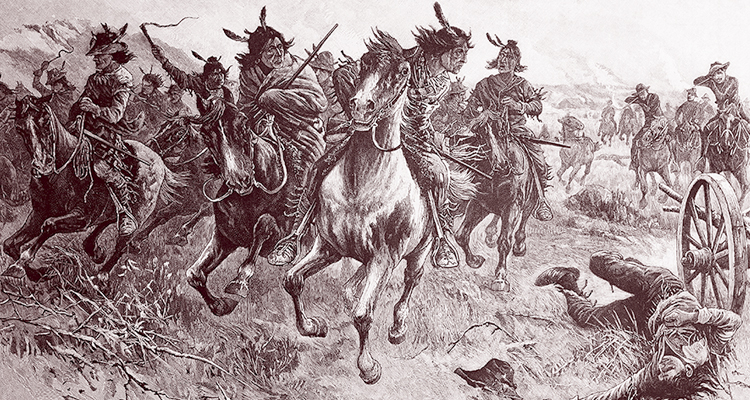The 1939 John Ford/John Wayne classic Stagecoach is loaded with Western clichés—a good badman looking for redemption, a good bad girl looking for a man who treats her decent, a good citizen (a banker no less) gone bad, a good doctor disguised as a bad drunk, a good, in-the-nick-of-time cavalry charge, and Indians who behave badly because they are Indians. But some of these clichés only became full-fledged after B Westerns of the 1940s and ’50s had run them into the lonesome prairie instead of cutting them off at the pass. Stagecoach transcends the typical mossbacked oaters with its careful character development and grand Monument Valley backdrop. Still, there are those bad Indians doing their thing—relentlessly attacking the coach, casualties be damned.
No question, though, that attack put an extra dash of motion and emotion into this motion picture (and set high standards for future action sequences, not just in Westerns). When I first watched Stagecoach as a boy (on the little screen not the big one), I naturally marveled at the “under the stagecoach” maneuver, pulled off by Yakima Canutt dressed as an Indian, and the “jump from the coach to horse to horse to horse to recover the loose reins” maneuver, pulled off by Yakima Canutt dressed as Wayne’s Ringo Kid. And those Apaches giving chase actually struck terror in my heart, even though by then I had already seen many happy (well, for white folks, anyway) Hollywood endings and suspected that in the real Wild West the Indians were too busy circling wagon trains and killing Custer to bother with stagecoaches. Sure there were stagecoach holdups on the frontier, the young pre-editor decided, but these were all done by the likes of Black Bart, seeking to obtain gold and other treasures from the strongbox, not to kill passengers in the coach. One thing is for certain: A boy who made all of his long trips in the back seat of a gas-guzzling station wagon devoted undue thinking time to stagecoach travel.
So, was the young pre-editor correct in assuming Indian attacks on stagecoaches are pure Hollywood malarkey? In a word no, says Indian wars expert Gregory Michno, who writes in this issue, “Stagecoach attacks were not a fiction concocted in the minds of novelists and filmmakers.” Good student of history that he is, Michno provides several examples, including an 1854 Mescalero Apache attack on two stagecoaches in southern Texas; an 1861 strike by Cochise’s Chiricahua Apaches on one of John Butterfield’s stagecoaches near the New Mexico–Arizona border; and a September 1866 Paiute attack in Oregon on the loot-laden Dalles and Canyon City stage line. Usually, though not in the last example, the attackers were after only the horses or mules. One man certain that Indians attacked coaches was Ben “Stagecoach King” Holladay, who owned the Overland Stage Co. in the early 1860s and later claimed Indian depredations had cost him nearly $370,000.
Down in Arizona Territory in April 1871 ambushers believed to be Indians hit a stagecoach 8 miles west of Wickenburg and killed six travelers, scalping two of them. Some folks have suggested alternative badmen (such as Mexican bandits), but in this case the attackers almost certainly were Yavapais, historically and culturally associated with the Tonto Apaches. Our upcoming June 2015 issue will feature more on that true incident, which certainly lacked the happy ending of Stagecoach. But as author R. Michael Wilson points out, the 1939 Western movie was based on “The Stage to Lordsburg,” a 1937 short story by Ernest Haycox with many parallels to the Wickenburg Massacre. An attack by Yavapai Indians lacks the pizazz of one perpetrated by Geronimo’s Apaches, however, so naturally it is the latter who chase the Lordsburg-bound coach in both the short story and the film. Print the legend, indeed, and in the name of John Ford go with the legend on the big screen to boot.





